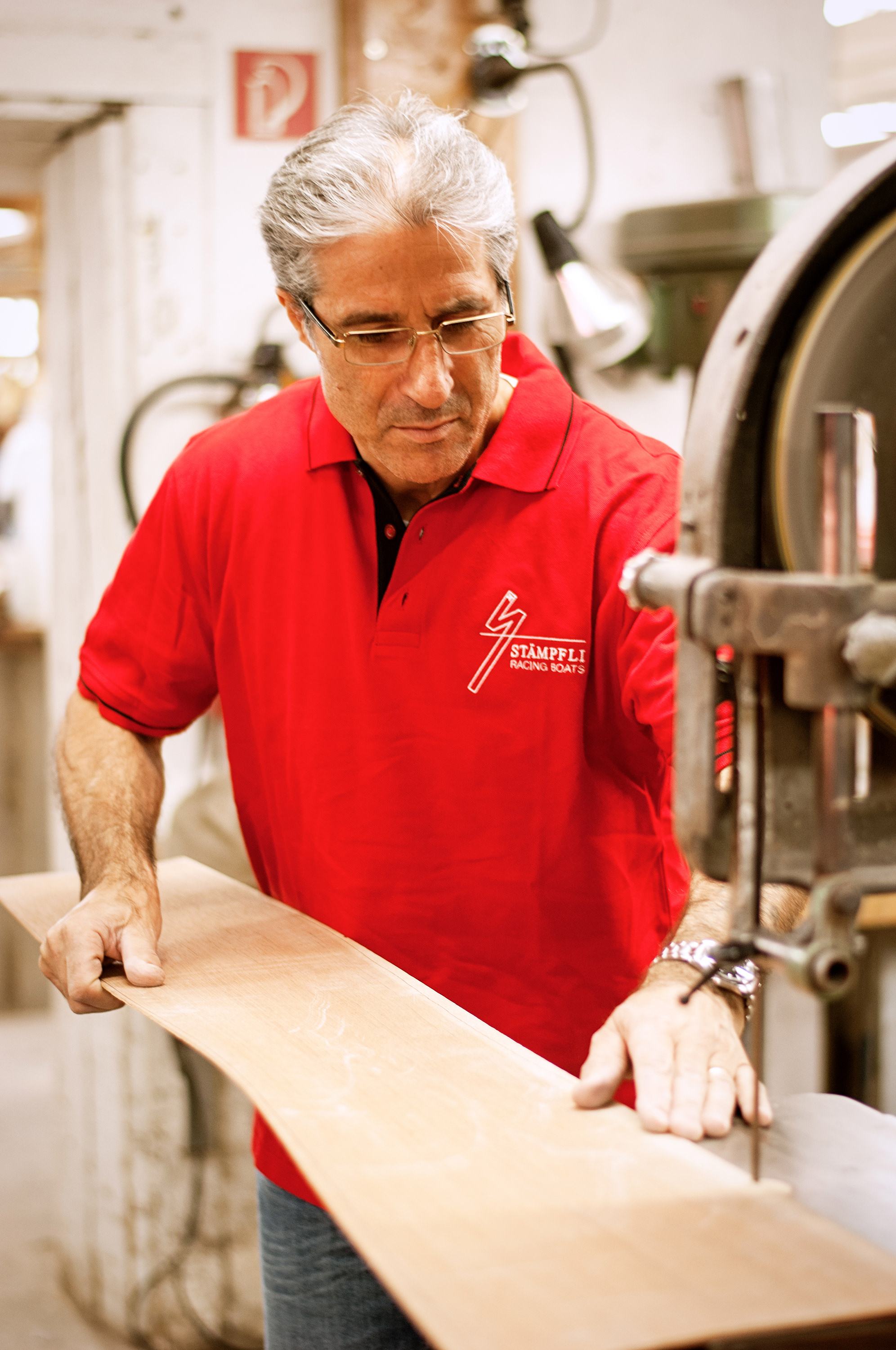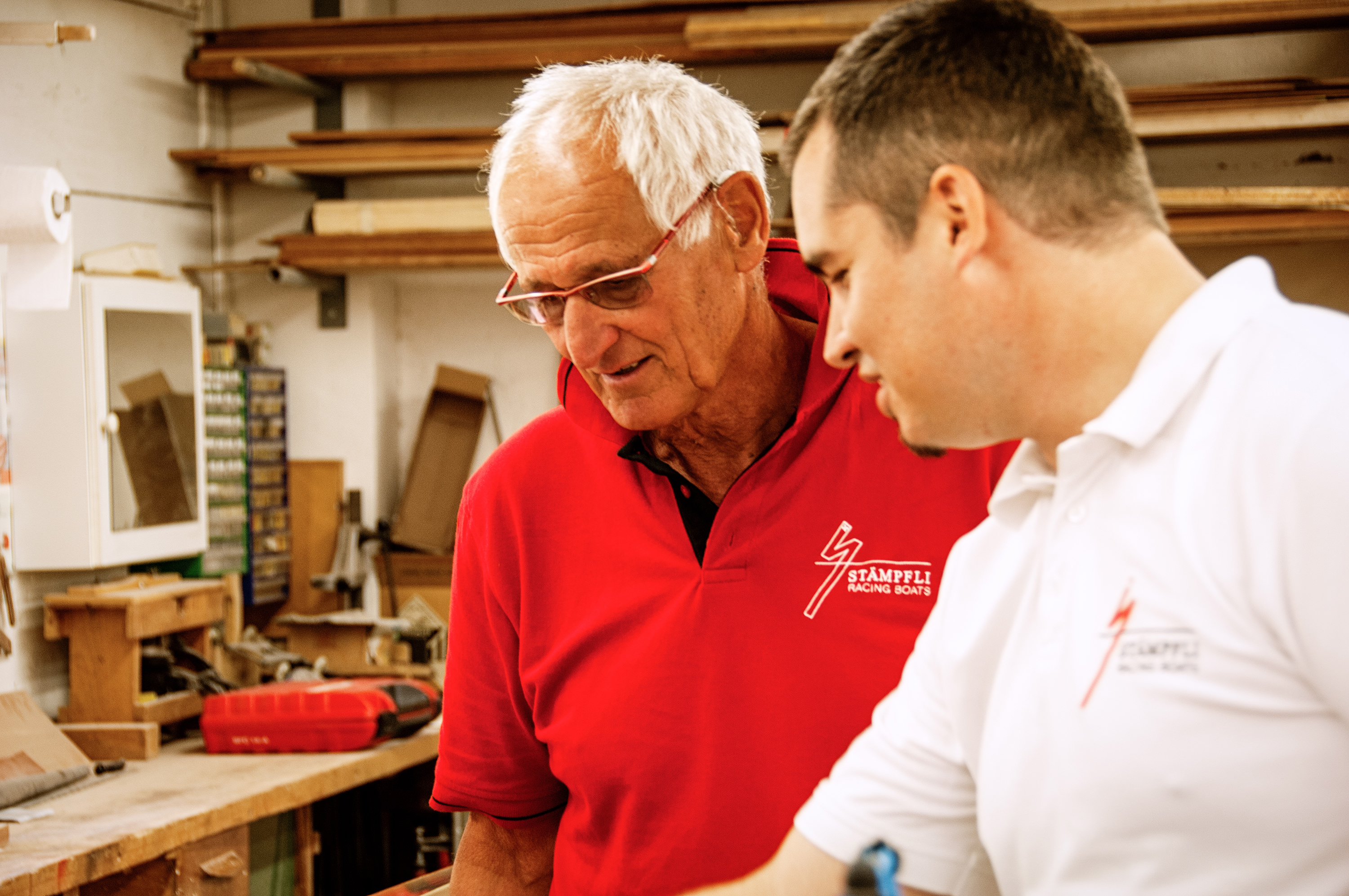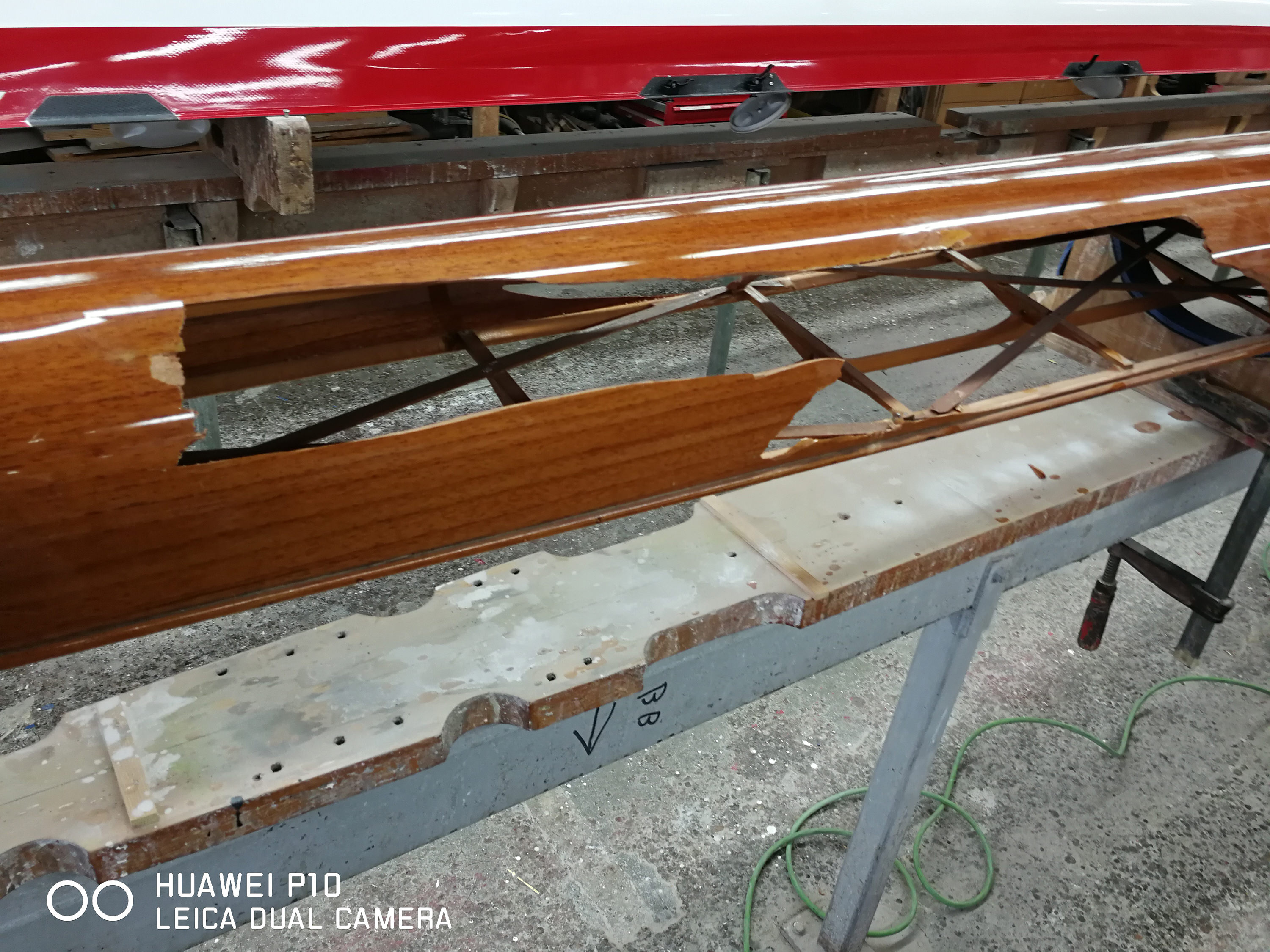Those in the know readily compare Stämpfli wooden boats with the famous Italian violins. It is a piece of craftsmanship with a history and pedigree that can accompany a rower throughout their entire life – even the sound it makes on the water is unique. In fact, wooden boats absorb sound, which allows the rower to enjoy a special kind of peace on the water. In contrast to the renowned Stradivarius, the Stämpfli dockyard still builds its racing boats out of wood today – and by hand, using almost the exact same process that was used hundreds of years ago. That is why no two ways of wooden boat building will ever be the same. The narrow hull struts of a Stämpfli are visible through its transparent top. A classic Stämpfli boat made from thin cedarwood is also a thing of beauty.
Passion – tempo – tradition. Wood chippings fly, a wood plane swishes and the smell of wood glue and varnish fills the air as the small team of boatbuilders from Stämpfli Racing Boats in Zurich’s Wollishofen district breathes new life into a racing boat made from wood. Right in the thick of it is a former European and World Champion rower.
Turning old into new
Every now and then, a “Stradivarius of the sea” will find its way back to the workshop on Lake Zurich. Melchior Bürgin explains: “Rowers who appreciate timber craftsmanship and aesthetics – the true connoisseurs – are the ones who bring their boats back to be serviced.” Often, he says, it can “fall very heavy on the heart to make the decision whether a wooden boat should be repaired or scrapped.” Many of them nurture and care for their boat themselves over the years. It is only when there is real damage to their boat – due to a collision with driftwood or another rowing boat, for example – that they bring their boat back to its birthplace, the dockyard in Wollishofen. Many a rowing club will scrap boats like this at some point in order to make space for the modern synthetic boats. For Bürgin, this is not a very sustainable way of thinking, as “synthetic boats are often replaced after only a few years, whereas wooden boats can serve for between 30 and 40 years.” These words are spoken with a great deal of experience and passion. “Wooden boats require more repair work. But this can be dealt with over decades and the repairs can be kept under control. However, the sport has grown significantly since the advent of rowing machines – people learn the technique quickly, but do not know how to maintain the boats.” In other words, you have to treat all boats with care, whether they are made out of wood or synthetic material.
Stämpfli is countering this throw-away culture by collecting old boats. “We give many of them away to clubs who can’t afford new boats. We also restore some of the particular treasures or timeless classics”, says Bürgin and adds “The boats that we cannot save or that are still with us after several years sometimes find a place in someone’s home or office as a nice piece of furniture, like a table, bookshelf or even a sideboard.” The sky’s the limit in this regard, he says with a smile.
40
years can serve wooden boats

The skiff “Espresso” was badly
damaged following a collision
with another boat and was going
to be scrapped. Stämpfli restored
the last wooden boat to win a
medal in a world championship.
A timeless classic
One of the boats that Stämpfli “rescued” themselves is the skiff “Espresso”. Following a collision with another boat, which resulted in the bow of Espresso being destroyed, the rowing club didn’t want to have it restored. However, for the men at Stämpfli there was no question that the boat would be repaired – after all, this is the boat that was the last Stämpfli wooden boat to win a medal in the 1995 World Championships. The boatbuilders of the Stämpfli dockyard are convinced: “Old things don’t need to be thrown away. Here, we make something new from something old.” However, the throw-away mentality is also unfortunately taking with it people’s appreciation for craftsmanship. Only “beautiful things, things worth keeping” are restored now.
One of the boats that Stämpfli “rescued” themselves is the skiff “Espresso”. Following a collision with another boat, which resulted in the bow of Espresso being destroyed, the rowing club didn’t want to have it restored. However, for the men at Stämpfli there was no question that the boat would be repaired – after all, this is the boat that was the last Stämpfli wooden boat to win a medal in the 1995 World Championships. The boatbuilders of the Stämpfli dockyard are convinced: “Old things don’t need to be thrown away. Here, we make something new from something old.” However, the throw-away mentality is also unfortunately taking with it people’s appreciation for craftsmanship. Only “beautiful things, things worth keeping” are restored now.
Old things don’t need to be thrown away. Here, we make something new from something old.– Melchior BürginExperience is in demand
Even where the craft of wooden boat building is concerned, modern technology can help here and there to restore or repair something. Adhesives, for example, have become stronger and more powerful. But, otherwise, the work is much the same as it always has been. Bürgin sees it as a positive thing that young people are coming back to the challenge of working with wood. Young people also know that they have more to learn in this regard than just how to use wood. Melchior Bürgin is a living legend in the Swiss rowing community and is even a former World and European Champion rower himself. He knows what he is talking about when he philosophises about the feeling of gliding when rowing. His memoirs were published recently, detailing the many years he spent as a professional rower. The book also contains numerous anecdotes about boats and fleets that Stämpfli once flew all over the world and sailed in international regattas. Even though Bürgin has since passed on the business to the younger generation, his former apprentice Daniel Zlinszky, he is still involved whenever possible and wherever he is needed.
Rapid and reliable
When it comes to racing boats, form should also always follow function – and that is, above all, to be fast. When asked if there is still potential for further developing the racing boat, Bürgin expanded on the issue and explained the relationship between shape and frictional resistance of the rowing boat (8 % versus 90 %). Less importance is to be placed on the shape, which is why development is “more focused on fittings, booms, rudders and footrests” with the aim of creating a more simple transfer of forces, as well as making the material more durable and handling easier. The weight of the boat (the current lower limit for a single scull is 14 kg) could be further reduced whilst maintaining the same level of durability. For rowers who are not counting on being able to squeeze every last tenth of a second out of their boat, wooden boats still represent an aesthetically attractive and sustainable alternative. For Stämpfli, they very much remain a matter of the heart.
When it comes to racing boats, form should also always follow function – and that is, above all, to be fast. When asked if there is still potential for further developing the racing boat, Bürgin expanded on the issue and explained the relationship between shape and frictional resistance of the rowing boat (8 % versus 90 %). Less importance is to be placed on the shape, which is why development is “more focused on fittings, booms, rudders and footrests” with the aim of creating a more simple transfer of forces, as well as making the material more durable and handling easier. The weight of the boat (the current lower limit for a single scull is 14 kg) could be further reduced whilst maintaining the same level of durability. For rowers who are not counting on being able to squeeze every last tenth of a second out of their boat, wooden boats still represent an aesthetically attractive and sustainable alternative. For Stämpfli, they very much remain a matter of the heart.
iNFO
The Stämpfli boat shape has tradition. Today, it is still the famous, fast Stämpfli shape that made the dockyard of Alfred Stämpfli one
of the largest and most successful in the industry right up until the 1980s. Time and again, teams have fought for victory in Stämpfli
boats at World Championships and the Olympics. Many developments and innovations in rowing boatbuilding have originated from
Stämpfli. Then in the 1980s, synthetic boats that could be produced faster and easier came onto the market – composite constructions
made from honeycomb material and carbon. Stämpfli also began producing lightweight synthetic boats – in red and white. The shape
of the boat – i.e. its cross-section – which is so important for stability and glide, was and continues to be the same as the wooden
boats in many respects. Despite or because of this, the wooden boats are now a dying breed. They are virtually never seen at world
championship competitions any more.



